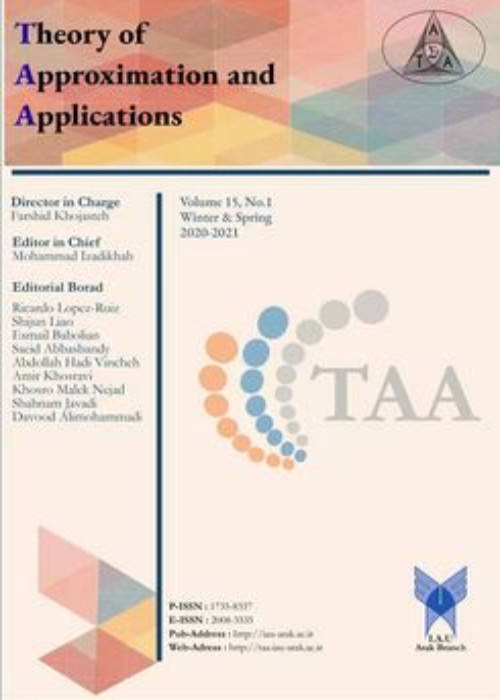فهرست مطالب
Theory of Approximation and Applications
Volume:4 Issue: 2, Summer and Autumn 2008
- تاریخ انتشار: 1387/12/15
- تعداد عناوین: 9
-
Ranking of fuzzy numbers by two methods the distance minimization and centroid pointPage 1Asady and Zendehnam employed ``distance minimization'' to ranking fuzzy numbers in [4]. Then Abbasbandy and Hajjari in [3] found a problem of its. To overcome it problem, they proposed magnitude method to ranking fuzzy numbers. Unfortunately, their method can not to overcome this problem. In this paper, we want to indicate this problem and then propose a revised method for distance minimization method which can avoid problem for ranking fuzzy numbers.
-
Numerical Integration by Bernstein PolynomialsPage 2In this work we find a numerical integration of a function by three approximations of the function using Bernstein polynomials, and compare them.
-
On dynamic efficiencyPage 3Recently, in the field of OR the performance analysis of DMUs has been dealt with in the presence of time factor by dynamic DEA, an analytical framework of DEA. This paper provides some new results on the dynamic efficiency.
-
On the Generalized and Drazin Inverses in C*-algebrasPage 3In this paper we show that the Drazin inverses is covariant under the group of all invertible elements in a C*-algebra. Moreover, we present some properties of Moore-Penrose and weighted Moore-Penrose inverses.
-
Integral operator defined by K-th Hadamard product of hypergeometric functionsPage 4We define an integral operator on the class A of analytic functions in the unit disk involving k-th Hadamard product (convolution) of hypergeometric functions. This operator is a generalization to Noor integral operator for hypergeometric functions, Carlson- Shaffer convolution operator and the integral operator involving k-th Hadamard product (convolution) of Koebe function given by the authors. New classes containing this operator are established. Characterization and other properties of these classes are discussed. Moreover, subordination and superordination results involving this operator are obtained.
-
Parametric approximation of fuzzy numberPage 5In this paper we consider a new method for approximation of fuzzy numbers. Numerical example will be presented to illustrate the difference between of using our method and Nasibov''s and Peker''s method.
-
Multiple criteria supplier selection problemPage 6In a recent paper Ng [2] proposed a procedure for the multiple criteria supplier selection problem. But, he has not taken care of about making the weight of a certain criteria becomes 0. In actual applications, making the weight of a certain criteria 0 means that we throw away this criteria. Consequently, we explain that Ng-model is not appropriate to applications. And, we propose a new model to solve the multiple criteria supplier selection problem. Our model not only incorporates multiple criteria for supplier selection, but also maintains the effects of weights in the final solution, an improvement over the model proposed by Ng. An illustrative example is presented to compare our model and the Ng-model.
-
A new method for computation of Wiener index if C_4C_8(S) NanotorusPage 7The Wiener index of a graph G is defined as W﴾G﴿=½∑d﴾i¸j) where V(G) is the set of all vertices of G and for i,j in V(G), d(i,j) is the minimum distance between i and j. Ashrafi and yousefi (see A. R. Ashrafi and S. Yousefi, Computing the Wiener Index of a TUC4C8(S) Nanotorus, MATCH Commun. Math. Comput. Chem., 57(2)(2007), 403-410) computed the Wiener index of TUC_4C_8(S) Nanotorus. In this paper we use a new method to compute the Wiener index of these Nanotorus.
-
Economic efficiency measures with input prices in the form of rangesPage 8This study explores the assessment of cost efficiency using data envelopment analysis (DEA) models. Cost efficiency (CE) evaluates the ability to produce current outputs at minimal cost. Conventional cost efficiency measurement methods require the values for all inputs and outputs as well as input prices at each decision making unit (DMU) to be known exactly. In the case where exact values of input prices are unknown, and only the maximum and minimum bounds of input prices can be estimated for each DMU, we propose a pair of two-level mathematical programming problems, whose optimal values represent the optimistic and pessimistic cost efficiency measures. Then the two-level nonlinear program for the optimistic cost efficiency measure is transformed to a ordinary one-level linear program. Also we give an explicit formulae for computing the pessimistic CE measure. By solving the associated series of programs the cost efficiency intervals of all DMUs are obtained.


